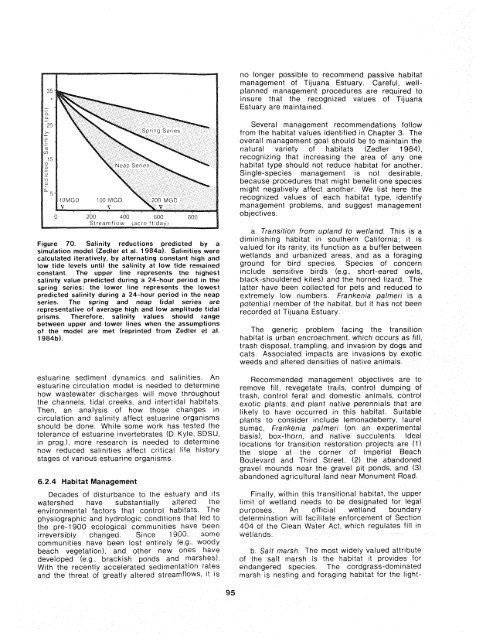The Ecology of Tijuana Estuary, California: An Estuarine Profile
The Ecology of Tijuana Estuary, California: An Estuarine Profile
The Ecology of Tijuana Estuary, California: An Estuarine Profile
You also want an ePaper? Increase the reach of your titles
YUMPU automatically turns print PDFs into web optimized ePapers that Google loves.
no longer possible to recommend passive habitat<br />
management <strong>of</strong> <strong>Tijuana</strong> <strong>Estuary</strong>. Careful, weilplanned<br />
management procedures are required to<br />
insure that the recognized values <strong>of</strong> <strong>Tijuana</strong><br />
<strong>Estuary</strong> are maintained.<br />
Several management recommendations follow<br />
from the habitat values identified in Chapter 3. <strong>The</strong><br />
overall management goal should be to maintain the<br />
natural variety <strong>of</strong> habitats (Zedler 19841,<br />
recognizing that increasing the area <strong>of</strong> any one<br />
habitat type should not reduce habitat for another.<br />
Single-species management is not desirable,<br />
because procedures that might benefit one species<br />
might negatively affect another. We list here the<br />
recognized values <strong>of</strong> each habitat type, identify<br />
management problems, and suggest management<br />
objectives.<br />
Figure 70. Salinity reductions predicted by a<br />
simulation model (Zedler et al. 1984a). Salinities were<br />
calculated iteratively, by alternating constant high and<br />
low tide levels until the salinity at low tide remained<br />
constant. <strong>The</strong> upper line represents the highest<br />
salinity value predicted during a 24-hour period in the<br />
spring series; the lower line represents the lowest<br />
predicted salinity during a 24-hour period in the neap<br />
series. <strong>The</strong> spring and neap tidal series are<br />
representative <strong>of</strong> average high and low amplitude tidal<br />
prisms. <strong>The</strong>refore, salinity values should range<br />
between upper and lower lines when the assumptions<br />
<strong>of</strong> the model are met (reprinted from Zedler et a!.<br />
1984b3.<br />
estuarine sediment dynamics and salinities. <strong>An</strong><br />
estuarine circulation model is needed to determine<br />
how wastewater discharges will move throughout<br />
the channels, tidal creeks, and intertidal habitats.<br />
<strong>The</strong>n, an analysis <strong>of</strong> how those changes in<br />
circulation and salinity affect estuarine organisms<br />
should be done. While some work has tested the<br />
tolerance <strong>of</strong> estuarine invertebrates (5. Kyle, SDSU,<br />
in prog.), more research is needed to determine<br />
how reduced salinities affect critical life history<br />
stages <strong>of</strong> various estuarine organisms.<br />
6.2.4 Habitat Management<br />
Decades <strong>of</strong> disturbance to the estuary and its<br />
watershed have substantially altered the<br />
environmental factors that control habitats <strong>The</strong><br />
physiographic and hydrologic conditions that led to<br />
the pre-1900 ecological communit~es have been<br />
lrreversr~iy changeo Since WOO, some<br />
communities have been lost entirely (e g , woody<br />
beach vegetation), and other new ones have<br />
developed (e g , bracklsh ponds and marshes)<br />
With the recently accelerated sed~mentation rates<br />
and the threat <strong>of</strong> greatly altered streamflows, it IS<br />
a. Transition from upland to wetland. This is a<br />
diminishing habitat in southern <strong>California</strong>; it is<br />
valued for its rarity, its function as a buffer between<br />
wetlands and urbanized areas, and as a foraging<br />
ground for bird species. Species <strong>of</strong> concern<br />
include sensitive birds (e.g., short-eared owls,<br />
black-shouldered kites) and the horned lizard. <strong>The</strong><br />
latter have been collected for pets and reduced to<br />
extremely low numbers. Frankenia palmer; is a<br />
potential rnember <strong>of</strong> the habitat, but it has not been<br />
recorded at <strong>Tijuana</strong> <strong>Estuary</strong>.<br />
<strong>The</strong> generic problem fac~ng the transition<br />
habitat is urban encroachment, whrch occurs as f~ll,<br />
trash disposal, trampling, and Invasion by dogs and<br />
cats Associated impacts are invasions by exotic<br />
weeds and altered densities <strong>of</strong> native animals<br />
Recommended management objectives are to<br />
remove fill, revegetate trails, control dumping <strong>of</strong><br />
trash, control feral and domestic animals, control<br />
exotic plants, and plant native perennrals that are<br />
likely to have occurred in this habitat. Suitable<br />
plants to conslder include lemonadeberry, laurel<br />
sumac, Frankenfa palmer, (on an experimental<br />
basis), box-thorn, and nat~ve succulents [deal<br />
locations for transition restoration projects are (1)<br />
the slope at the corner <strong>of</strong> imperial Beach<br />
Boulevard and Thtrd Street, (2) the abandoned<br />
gravel mounds near the gravel pit ponds, and (3)<br />
abandoned agricultural land near Monument Road.<br />
Finally, within this transitional habitat, the upper<br />
limit <strong>of</strong> wetland needs to be designated for legal<br />
purposes <strong>An</strong> <strong>of</strong>ficial wetland boundary<br />
determinat~on will facilitate enforcement <strong>of</strong> Section<br />
404 <strong>of</strong> the Clean Water Act, which regulates fill in<br />
wetlands<br />
b Saft marsh <strong>The</strong> most widely valued attr~bute<br />
<strong>of</strong> the salt marsh is the habrtat it provides for<br />
endangered species <strong>The</strong> cordgrass-dominated<br />
marsh is nesting and foraging habitat for the light-

















